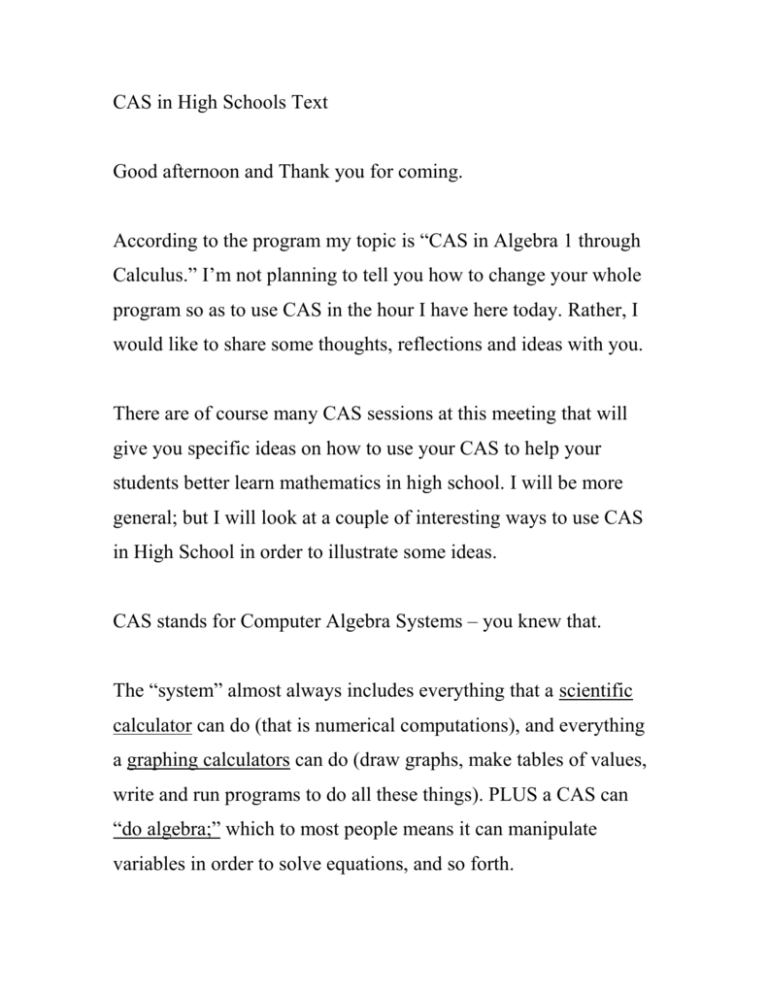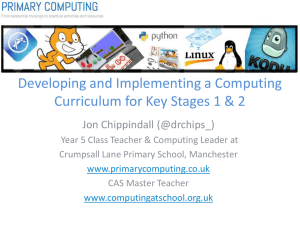
CAS in High Schools Text
Good afternoon and Thank you for coming.
According to the program my topic is “CAS in Algebra 1 through
Calculus.” I’m not planning to tell you how to change your whole
program so as to use CAS in the hour I have here today. Rather, I
would like to share some thoughts, reflections and ideas with you.
There are of course many CAS sessions at this meeting that will
give you specific ideas on how to use your CAS to help your
students better learn mathematics in high school. I will be more
general; but I will look at a couple of interesting ways to use CAS
in High School in order to illustrate some ideas.
CAS stands for Computer Algebra Systems – you knew that.
The “system” almost always includes everything that a scientific
calculator can do (that is numerical computations), and everything
a graphing calculators can do (draw graphs, make tables of values,
write and run programs to do all these things). PLUS a CAS can
“do algebra;” which to most people means it can manipulate
variables in order to solve equations, and so forth.
I will limit my remarks to the “doing algebra” aspect of the CAS
since that’s what really differentiates them from graphing
calculators (no pun intended).
First let me state my opinion that CAS should be in every students
hands beginning in first year algebra at the latest. My reason for
that is simple: they can learn more mathematics with a CAS than
without.
Let’s start then with the very basic question: “What is Algebra?”
The Oxford Desk Dictionary say algebra is the “branch of
mathematics that uses letter, etc. to represent numbers and
quantities.”
The (online) American Heritage Dictionary say algebra is “A
branch of mathematics in which symbols, usually letters of
the alphabet, represent numbers or members of a specified set
and are used to represent quantities and to express general
relationships that hold for all members of the set.”1
Another online source says algebra is “branch of
mathematics concerned with operations on sets of numbers or
other elements that are often represented by symbols.
Algebra is a generalization of arithmetic and gains much of
its power from dealing symbolically with elements and
operations (such as addition and multiplication) and
relationships (such as equality) connecting the elements.”2
And another: “A branch of mathematics marked chiefly by
the use of symbols to represent numbers, as in the use of a2 +
b2 = c2 to express the Pythagorean Theorem.”3 This from the
New Dictionary of Cultural Literacy – we should all be
culturally literate.
One more this time from Wikipedia: Elementary algebra, in
which the properties of operations on the real number system
are recorded using symbols as "place holders" to denote
constants and variables, and the rules governing
mathematical expressions and equations involving these
symbols are studied.”4
You get the idea – algebra is symbols and symbol manipulation.
But I never thought of algebra that way!
I knew that all that was part of algebra; but I don’t think that’s all it
did. I’d prefer to think of algebra as a method for solving
problems. I always thought of algebra as having 4 parts:
1. You begin with, for what of a better terms, I’ll call a
“problem” – some information that you need to know more
about. Sometimes something specific and sometimes
something more general. The “problem” is usually about
something that concerned numbers in one way or another.
2. Next the problem is expressed in terms of variables and
numbers and symbols telling you how they were related.
(That’s what makes an algebra problem different from your
personal problems, for example.) Sometimes the “problem”
starts at this step – already expressed in variables.
3. These symbols were manipulated according to certain rules
to arrive at an “answer.”
4. The answer was then compared to the original problem to see
how well it worked. To see if it is a solution.
Apparently, according to the definitions I just read, algebra is
ONLY the third of those four things – the symbol manipulation
part!
If so that’s really good news – we can forget about all that “real
world” stuff and just concentrate on teaching the manipulation the
variables, and of course we won’t want a CAS, because the goal
would be to teach symbol manipulation.
Well no, we can’t do that. If you like my definition then the really
good news is that computer algebra systems can do that third step
for us and lets us and our students concentrate on the real algebra
in a real setting, concentrating on solving the problem, not just
solving the equation.
I suggest then that we let the CAS do Part 3 and we and our
students concentrate on Parts 1, 2 and 4.
I propose that it is important for students to be knowledgeable
about symbols and why and how they are manipulated, but it is not
important to be very good at manipulating symbols.
After all Newton wasn’t even good at arithmetic.5
SHOW NEWTON PAGE
Before we look at some examples let me take a short side trip.
To be used to its full advantage CAS will require changes in how
we think about mathematics and about the high school curriculum.
This is not a new thing. The topics taught in school are not,
contrary to popular opinion, set in stone. Here is a short list of
changes I’ve seen in my teaching career. (Okay that’s a long time!)
Computing square roots by “the algorithm.” No more.
Which gave way to: looking square roots up in tables along
with using simplified radical form to find the decimal values.
No more.
We no longer teach computations with logarithms (expand).
No more.
We do not teach looking up functions in trig (or log) tables
No more.
Interpolation in tables. No more.
Degrees, minutes and seconds have given way to decimal
degrees
Newton’s Method has been dropped from the AP calculus
course description (expand)
And rationalizing denominators is on its death bed.
In a few minutes I’ll suggest some others things that can be
dropped. (Stay tuned)
Here are some ways that I think CAS can be used. This is certainly
not an exhaustive list.
I’ll try to be very general, but the theme is always the same: Let
the CAS do the grunt work.
1. Delving into topics that require – on the side so to speak –
manipulations and computations. These manipulations and
computations detract from the point. Example:
Prime factorization. How much time do you spend teaching
methods (or a method) of factoring integers and how much
do you spend using the factorization to learn about the
properties of numbers? How you get the factors is not
important; how you use them is.
GO TO TI-INTEACTIVE There are quite a few CAS that are
available. The TI Voyage 200 is my favorite, but there’s the
TI89; HP models. Casio Class Pad, Maple, Mathematica, and
other. I’m sure some good open source software will be
available soon. I’m using TI-Interactive today because it will
be easy for you to see and the syntax is almost identical to the
TI89.
Factor(100!)
Factor({24,18})
LCM(24,18)
Factor(ans)
GCD(24,18)
Factor (ans)
50 ,
5000
2. Step-by-step solutions
a. Equations
b. Formulas
c. Systems of Equations6
d. Comment: This is not really an important use IMO, but
it does help students learn the steps without worrying
about the arithmetic and shows their mistakes at once.
3. Data on Symbol use
a. a+a+a+a+a = 5a and a a a a a = a^5
b. Practice with symbols: Example: Use seq( to write {3,
6, 9, 1,2 15} as many different ways as you can .
c. Theory of equations
i. (x + a)(x + b)(x + c) …. And examine patterns in
coefficients
ii. Binomial theorem
4. Complicated computations – CUBIC SYMMETRY
IF
TIME
5. One line programs
a. Analytic geometry’s 5 formulas
1. Slope
2. distance
3. midpoint
4. equation of a line
5. angle between lines
b. Example 1 Is ()()()() a parallelogram?
c. Equation of a HYPERBOLA
d. Example 2 Law of Sines/ Cosines SET MODE (f9)
TO DEGREES, SET RANGE FOR ANGLE DO sss,
sas, asa
This last example gives us more things to add to our list of
things that won’t be around much longer.
Law of Sines
DISCUSS
Law of Cosines
Quadratic formula
Now before you go away thinking I live in some kind of ideal
world, let me assure you I know the issues. Here they are some of
them:
Equity
This is usually framed like this: since everyone (or
everyone’s school district) cannot afford a CAS it is unfair to
let others use them; they will have an unfair advantage. Well
in a way that’s true; they will have an unfair advantage, but
that, IMO is not the real equity issue.
The real issue is if you can learn more math and learn the
math better with a CAS, then it’s unfair to deprive anyone of
a CAS. Everyone should have one! And it’s unfair to those
who have a CAS to forbid them from learning with it.
Standardized tests ARE the curriculum. As long a
standardized test require by hand rationalization of
denominators then damn it, we’re gonna teach by hand
rationalization of denominators. Even if it’s a waste of time
and mind numbing.
Teacher training. There will be resistance from teachers
(beside those area listed above) because they too are
intimidated by technology.
What p&p is to be retained? Some must be. Perhaps enough
for students to understand what the CAS is doing, but maybe
not how it’s doing it.
How students should show their work done on a CAS. Copy
it onto their paper. Turn in a computer output, show the
teacher the screen. Needs to be decided.
Mathematical “beauty.” I assure you I think the Law of Sines
is one of the most beautiful things in mathematics. Nothing
like it. But ….
1
The American Heritage® Dictionary of the English Language, Fourth Edition
Copyright © 2004, 2000 by Houghton Mifflin Company. Published by Houghton Mifflin
Company. All rights reserved.
2
The Columbia Electronic Encyclopedia, Sixth Edition Copyright © 2003, Columbia
University Press. Licensed from Columbia University Press. All rights reserved.
www.cc.columbia.edu/cu/cup/
3
The New Dictionary of Cultural Literacy, Third Edition Edited by E.D. Hirsch, Jr., Joseph F. Kett, and
James Trefil. Copyright © 2002 by Houghton Mifflin Company. Published by Houghton Mifflin.
4
www.wikipedia.com “Algebra”
5
Isaac Newton by JamesGleick, Vintage Books, New York, © 2003, p. 37.
6
“XXX” in The Mathematics Teacher October 2006.p. xxx








